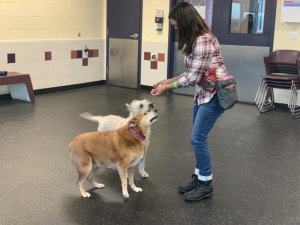Allison Hartlage, CTC, KPA CTP, CBCC-KA, CNWI
Director of Animal Training & Behavior
You may not be aware, but animal training is an unregulated industry. This means that anyone (anyone!) can call themselves a trainer, regardless of their formal experience or educational background. While there are some people who have dedicated years to mastering science-based learning and the art and application of animal training, there are others who are simply self-professed trainers who may have done nothing more than watch dog training TV shows or feel they are qualified to train other people’s dogs because they “grew up with dogs their entire life”.
Additionally, animal trainer certifications vary in what they measure, whether they require testing, and what skills and expertise they attest to. To make an already complicated industry even more muddied, trying to understand the “alphabet soup” of credentials behind trainer’s names can be confusing and overwhelming – what do all of those letters mean? It is important to choose a trainer who has invested in their education and who has taken an oath to teach best practices. You wouldn’t hire a lawyer or doctor who did not pass rigorous standards/tests before a governing body, would you?
1. Choose a trainer committed to force-free, reward-based training.
To help you sort out who walks the talk, I’ve borrowed some recommended questions from world-renowned dog trainer, Jean Donaldson, that can help you to narrow in on people who are truly committed to safety and mental wellness for your animal. Ask these three things:
- One: Exactly what will happen to my dog if they get the behavior right?
- Two: Exactly what will happen to my dog if they get the behavior wrong?
- Three: Are there any less invasive alternatives to what you propose?
As learners, we are likely to repeat behaviors that are followed by something we find pleasant, desirable or want to happen again. For part one of this question (what will happen when my dog gets the behavior right?), a skilled, ethical, force-free trainer should answer: play, toys, high-value food, or access to what makes your individual dog happy.
For part two (what will happen when my dog gets it wrong?), my preferred answer would be redirection of the dog’s attention, figuring out and training an appropriate alternative behavior that we want the dog to perform instead, or removing whatever the dog may find reinforcing about the situation (for example, removing attention).
There is no need for a trainer or technique to scare or harm your dog. Pain, fear, coercion and force are not needed, are not best-practice, and can have many negative side effects.
2. Choose a trainer committed to continuing education. We are always learning new (and better) ways to communicate with and understand our companion animals and to influence their behavior. Look for a trainer who is current on today’s scientific understanding of animal learning, training and welfare best practices.
3. Choose a trainer who communicates clearly and respectfully. You are a learner, too! A skilled trainer should be able to apply force-free, reward-based strategies to you as well as your pet. A good trainer should be able to explain concepts, exercises and lessons in a way that works for you.
4. While trainers of varying certifications can be highly skilled and effective, here is a list of some well-regarded certifications you might start with when you begin your search.
- DACVB – Diplomate of the American College of Veterinary Behavior
- CBCC-KA – Certified Behavior Consultant Canine Knowledge Assessed
- CTC – Certificate in Training and Counseling from The Academy of Dog Trainers
- KPA CTP – Karen Pryor Academy Certified Training Partner
- IAABC – International Association of Animal Behavior Consultants – Dog, Cat, Horse, Parrot
While the titles of “animal trainer” and “behaviorist” can be used by anyone, regardless of their educational background or experience, there are a few exceptions to this!
- ACAAB – Associate Certified Applied Animal Behaviorist – this requires a master’s degree.
- CAAB – Certified Applied Animal Behaviorist – this requires a Ph.D. level degree.
- DACVB – Diplomate of the American College of Veterinary Behavior.
Most importantly, if anyone asks you to do anything to your dog that makes you feel uncomfortable, that scares, intimidates or hurts your dog in any way, please find a new trainer! Behavior change takes time for all of us, there are no quick fixes or magic cures to learning and change. There also aren’t any guarantees – beware of those who tell you otherwise. Training and learning should be fun and connective. We hope this helps you to find a trainer who can facilitate that experience for you and your beloved pet(s)! We’re here to support you.
Learn more about our talented and highly qualified Training & Behavior Team.
Learn more about our Training Services.
Happy Training!
